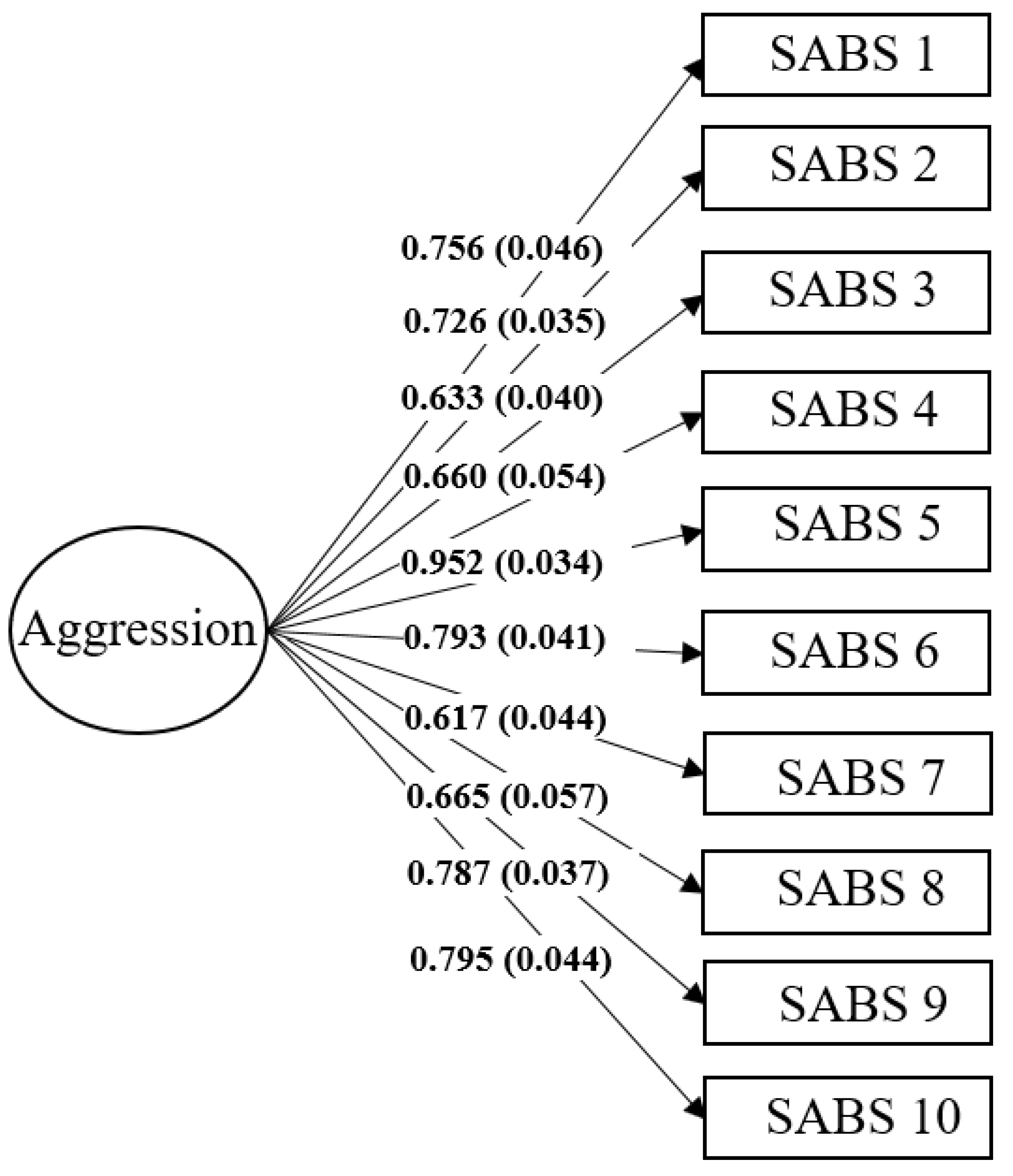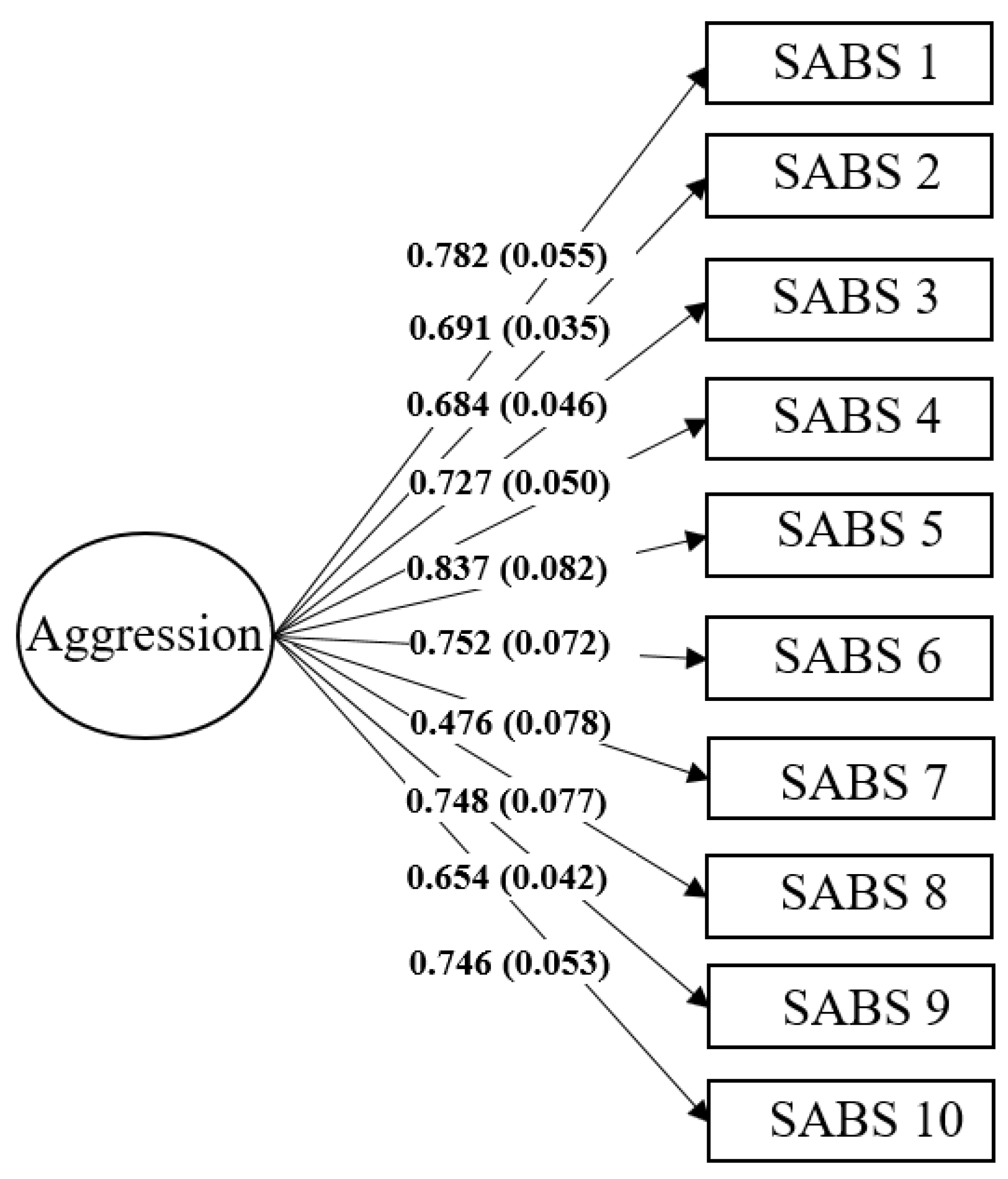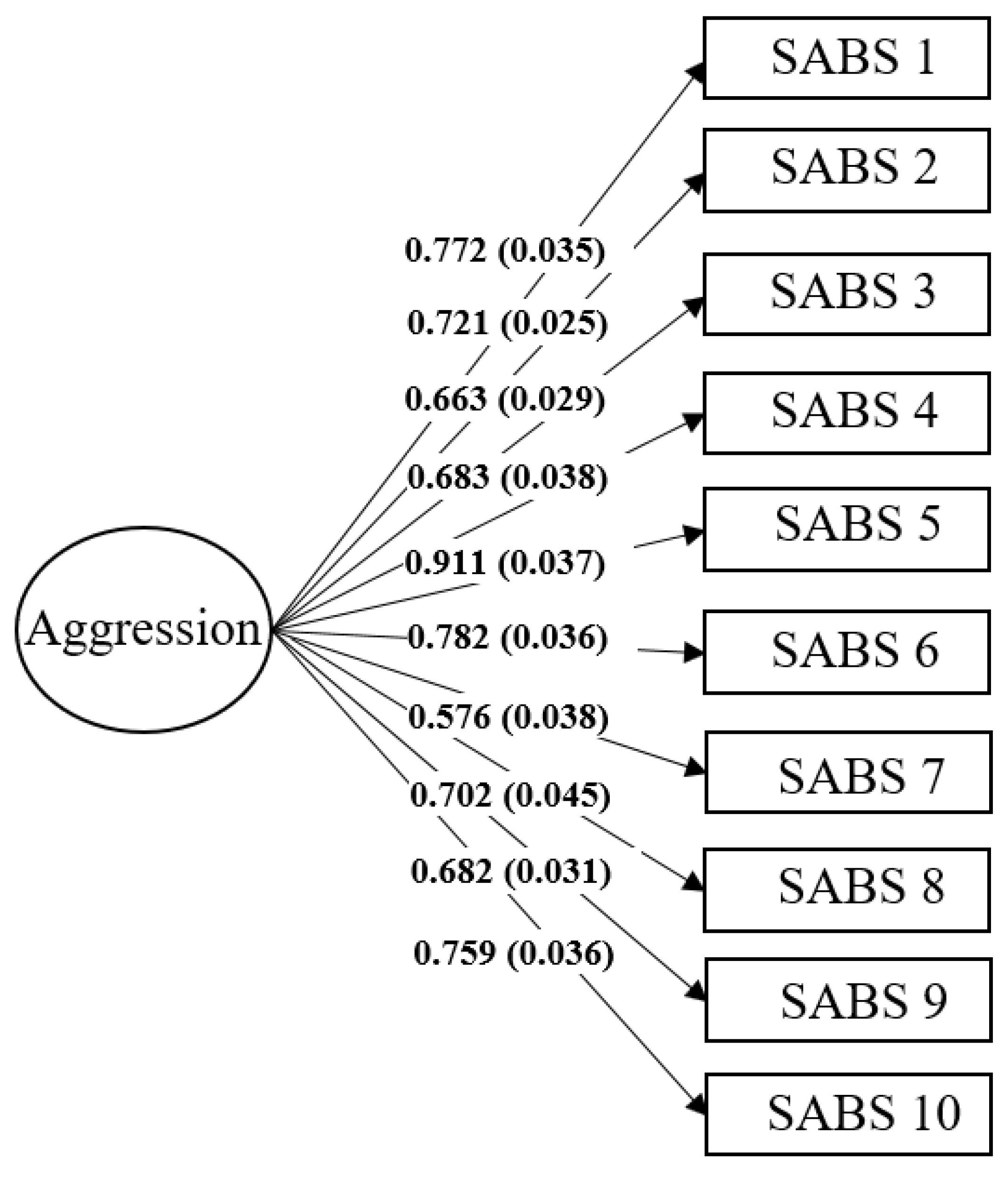Dimensionality and Measurement Invariance of the Sexually Aggressive Behaviors Scale across Male and Female Portuguese College Students
Abstract
:1. Introduction
1.1. Sexual Violence in Community Samples
1.2. Risk Factors
1.3. This Study
2. Materials and Methods
2.1. Participants and Procedures
2.2. Measures
2.2.1. Sexually Aggressive Behaviors Scale
2.2.2. Rape Myths Scale
2.2.3. Youth Psychopathic Traits Inventory—Short Version
2.2.4. Personal Assessment of Intimacy in Relationships Scale
2.3. Data Preparation and Statistical Analysis
3. Results
3.1. Descriptive Statistics
3.2. Confirmatory Factor Analysis (CFA)
3.3. Convergent and Discriminant Validity
3.4. Measure of Invariance
3.5. Latent and Observed Mean Differences in Sexual Aggression
3.6. Reliability
4. Discussion
5. Conclusions
Author Contributions
Funding
Institutional Review Board Statement
Informed Consent Statement
Data Availability Statement
Conflicts of Interest
References
- Basile, K.C.; Smith, S.G.; Breiding, M.; Black, M.C.; Mahendra, R.R. Sexual Violence Surveillance: Uniform Definitions and Recommended Data Elements, Version 2.0; National Center for Injury Prevention and Control, Centers for Disease Control and Prevention: Atlanta, Georgia, 2014. [Google Scholar]
- O’Neil, M.; Morgan, P. American Perceptions of Sexual Violence; FrameWorks Institute: Washington, DC, USA, 2010. [Google Scholar]
- Iglesias, P.S.; Sierra, J.C. Sexual victimization among spanish college women and risk factors for sexual revictimization. J. Interpers. Violence 2012, 27, 3468–3485. [Google Scholar] [CrossRef] [PubMed]
- Krahé, B.; Berger, A.; Vanwesenbeeck, I.; Bianchi, G.; Chliaoutakis, J.; Fernández-Fuertes, A.A.; Fuertes, A.; de Matos, M.G.; Hadjigeorgiou, E.; Haller, B.; et al. Prevalence and correlates of young people’s sexual aggression perpetration and victimization in 10 European countries: A multi-level analysis. Cult. Health Sex. 2015, 17, 682–699. [Google Scholar] [CrossRef] [PubMed]
- Öberg, M.; Skalkidou, A.; Heimer, G.; Lucas, S. Sexual violence against women in Sweden: Associations with combined childhood violence and sociodemographic factors. Scand. J. Public Health 2021, 49, 292–300. [Google Scholar] [CrossRef] [PubMed]
- Kassa, G.M.; Abajobir, A.A. Prevalence of violence against women in Ethiopia: A meta-analysis. Trauma Violence Abus. 2020, 21, 624–637. [Google Scholar] [CrossRef]
- Winzer, L.; Krahé, B.; Guest, P. The scale of sexual aggression in southeast Asia: A review. Trauma Violence Abus. 2019, 20, 595–612. [Google Scholar] [CrossRef]
- Schuster, I.; Krahé, B. Prevalence of sexual aggression victimization and perpetration in Chile: A systematic review. Trauma Violence Abus. 2019, 20, 229–244. [Google Scholar] [CrossRef]
- World Health Organization. Violence against Women Prevalence Estimates, 2018: Global, Regional and National Prevalence Estimates for Intimate Partner Violence against Women and Global and Regional Prevalence Estimates for Non-Partner Sexual Violence against Women. 2021. Available online: https://www.who.int/publications/i/item/9789240022256 (accessed on 5 January 2022).
- Casey, E.A.; Masters, N.T.; Beadnell, B.; Hoppe, M.J.; Morrison, D.M.; Wells, E.A. Predicting sexual assault perpetration among heterosexually active young men. Violence Against Women 2017, 23, 3–27. [Google Scholar] [CrossRef]
- Carvalho, J.; Sá, A. Male college studewnts using sexually aggressive strategies: Findings on the interpersonal relationship profile. J. Interpers. Violence 2017, 35, 646–661. [Google Scholar] [CrossRef]
- Carvalho, J.; Rosa, P.J.; Pereira, B. Dynamic Risk Factors Characterizing Aggressive Sexual Initiation by Female College Students. J. Interpers. Violence 2021, 36, 2455–2477. [Google Scholar] [CrossRef]
- Marshall, W.L. Intimacy, loneliness and sexual offenders. Behav. Res. Ther. 1989, 27, 491–504. [Google Scholar] [CrossRef]
- Martin, G.M.; Tardif, M. Examining sex offenders’ intimacy deficits: Their nature and their influence on sexually abusive behaviours. J. Sex. Aggress. 2015, 21, 158–178. [Google Scholar] [CrossRef]
- Hanson, R.K.; Morton-Bourgon, K.E. The characteristics of persistent sexual offenders: A meta-analysis of recidivism studies. J. Consult. Clin. Psychol. 2005, 73, 1154–1163. [Google Scholar] [CrossRef] [PubMed] [Green Version]
- O’Connell, D.; Marcus, D.K. Psychopathic personality traits predict positive attitudes toward sexually predatory behaviors in college men and women. Personal. Individ. Differ. 2016, 94, 372–376. [Google Scholar] [CrossRef]
- Mann, R.E.; Hanson, R.K.; Thornton, D. Assessing risk for sexual recidivism: Some proposals on the nature of psychologically meaningful risk factors. Sex. Abus. A J. Res. Treat. 2010, 22, 191–217. [Google Scholar] [CrossRef] [Green Version]
- Bouffard, J.A.; Bouffard, L.A.; Miller, H.A. Examining the correlates of women’s use of sexual coercion: Proposing an explanatory model. J. Interpers. Violence 2016, 31, 2360–2382. [Google Scholar] [CrossRef]
- Gannon, T.A.; Cortoni, F. Female Sexual Offenders: Theory, Assessment and Treatment; Wiley-Blackwell: West Sussex, UK, 2010. [Google Scholar]
- Hersh, K.; Gray-Little, B. Psychopathic traits and attitudes associated with self-reported sexual aggression in college men. J. Interpers. Violence 1998, 13, 456–471. [Google Scholar] [CrossRef]
- Mouilso, E.R.; Calhoun, K.S. The role of rape myth acceptance and psychopathy in sexual assault perpetration. J. Aggress. Maltreatment Trauma 2013, 22, 159–174. [Google Scholar] [CrossRef]
- Burt, M.R. Cultural myths and supports for rape. J. Personal. Soc. Psychol. 1980, 38, 217–230. [Google Scholar] [CrossRef]
- Lonsway, K.A.; Fitzgerald, L.F. Rape myths. Psychol. Women Q. 1994, 18, 133. [Google Scholar] [CrossRef]
- Yapp, E.J.; Quayle, E. A systematic review of the association between rape myth acceptance and male-on-female sexual violence. Aggress. Violent Behav. 2018, 41, 1–19. [Google Scholar] [CrossRef] [Green Version]
- DeGue, S.; DiLillo, D.; Scalora, M. Are all perpetrators alike? Comparing risk factors for sexual coercion and aggression. Sex. Abus. 2010, 22, 402–426. [Google Scholar] [CrossRef] [PubMed] [Green Version]
- Beech, A.; Parrett, N.; Ward, T.; Fisher, D. Assessing female sexual offenders’ motivations and cognitions: An exploratory study. Psychol. Crime Law 2009, 16, 201–216. [Google Scholar] [CrossRef] [Green Version]
- Carvalho, J.; Benzinho, E.; Robalho, R. Psychosexual characterization of college men and women reporting attempted sexual intercourse by coercive means. Presented at the 14th Congress of the European Federation of Sexology, Albufeira, Portugal, 9–12 May 2018. [Google Scholar]
- Trottier, D.; Benbouriche, M.; Bonneville, V. A meta-analysis on the association between rape myth acceptance and sexual coercion perpetration. J. Sex Res. 2021, 58, 375–382. [Google Scholar] [CrossRef] [PubMed]
- Mumford, E.A.; Potter, S.; Taylor, B.G.; Stapleton, J. Sexual Harassment and Sexual Assault in Early Adulthood: National Estimates for College and Non-College Students. Public Health Rep. 2020, 135, 555–559. [Google Scholar] [CrossRef]
- Koss, M.P.; Oros, C.J. Sexual Experiences Survey: A research instrument investigating sexual aggression and victimization. J. Cons. Cli. Psy. 1982, 50, 455–457. [Google Scholar] [CrossRef]
- Anderson, P.B. Correlates with college women’s self-reports of initiating heterosexual contact. Sex. Abus. A J. Res. Treat. 1996, 8, 121–131. [Google Scholar] [CrossRef]
- Moreira, B.; Carvalho, J.; Nobre, P. The Role of Dysfunctional Sexual Beliefs and Sexual Self-Esteem in Sexual Aggression: A Study with Male College Students. Int. J. Sex. Health 2021, 34, 308–318. [Google Scholar] [CrossRef]
- Rosa, P.J.; Brazão, N.; Carvalho, J. Psychometric properties of the Sexually Aggressive Behaviors Scale: Factor structure, reliability and construct validity in a sample of Portuguese female college students. Int. J. Offender Ther. Comp. Criminol. 2022, in press. [Google Scholar] [CrossRef]
- Martins, S.; Machado, C.; Abrunhosa, R.; Manita, C. Escala de Crenças sobre Violência Sexual [Rape Myths Scale]. Análise Psicológica 2012, 30, 177–191. [Google Scholar] [CrossRef] [Green Version]
- Van Baardewijk, Y.; Andershed, H.; Stegge, H.; Nilsson, K.; Scholte, E.; Vermeiren, R. Development and tests of short versions of the Youth Psychopathic Traits Inventory and the Youth Psychopathic Traits Inventory-Child Version. Eur. J. Psychol. Assess. 2010, 26, 122–128. [Google Scholar] [CrossRef]
- Pechorro, P.; Andershed, H.; Ray, J.V.; Maroco, J.; Gonçalves, R.A. Validation of the Youth Psychopathic Traits Inventory and Youth Psychopathic Traits Inventory—Short Version among incarcerated juvenile delinquents. J. Psychopathol. Behav. Assess. 2015, 37, 576–586. [Google Scholar] [CrossRef] [Green Version]
- Pechorro, P.; Ribeiro da Silva, D.; Rijo, D.; Gonçalves, R.A.; Andershed, H. Psychometric properties and measurement invariance of the Youth Psychopathic Traits Inventory—Short Version among Portuguese youth. J. Psychopathol. Behav. Assess. 2017, 39, 486–497. [Google Scholar] [CrossRef]
- Colins, O.; Andershed, H. The Youth Psychopathic Inventory Short Version in a general population sample of emerging adults. Psychol. Assess. 2016, 28, 449–457. [Google Scholar] [CrossRef] [PubMed]
- Schaefer, M.T.; Olson, D.H. Assessing intimacy: The PAIR inventory. J. Marital Fam. Ther. 1981, 7, 47–60. [Google Scholar] [CrossRef]
- Moreira, H.; Amaral, A.; Canavarro, M.C. Adaptação do Personal Assessment of Intimacy in Relationships Scale (PAIR) para a população Portuguesa: Estudo das suas características psicométricas [Adaptation of the Personal Assessment of Intimacy in Relationships Scale (PAIR) for the Portuguese population: Study of the psicometric characteristics]. Psychologica 2009, 50, 339–359. [Google Scholar]
- Schumacker, R.E.; Lomax, R.G. A Beginner’s Guide to Structural Equation Modeling, 4th ed.; Routledge: New York, NY, USA, 2016. [Google Scholar]
- Bentler, P.M. Comparative fit indexes in structural models. Psychol. Bull. 1990, 107, 238–246. [Google Scholar] [CrossRef]
- Steiger, J.H. Structural model evaluation and modification: An interval estimation approach. Multivar. Behav. Res. 1990, 25, 173–180. [Google Scholar] [CrossRef] [Green Version]
- Brown, T.A. Confirmatory Factor Analysis for Applied Research; The Guilford Press: New York, NY, USA, 2006. [Google Scholar]
- Tomás, C.; Rosa, P.J. Validation of a scale of religious and spiritual coping for the Portuguese population. J. Relig. Health 2021, 60, 3510–3529. [Google Scholar] [CrossRef]
- Fornell, C.; Larcker, D.F. Evaluating Structural Equation Models with Unobservable Variables and Measurement Error. J. Mark. Res. 1981, 18, 39–50. [Google Scholar] [CrossRef]
- Milfont, T.L.; Fischer, R. Testing measurement invariance across groups: Applications in cross-cultural research. Int. J. Psychol. Res. 2010, 3, 111–130. [Google Scholar] [CrossRef] [Green Version]
- Vandenberg, R.J.; Lance, C.E. A review and synthesis of the measurement invariance literature: Suggestions, practices, and recommendations for organizational research. Organ. Res. Methods 2000, 3, 4–70. [Google Scholar] [CrossRef]
- Muthén, L.K.; Muthén, B.O. Mplus User’s Guide; Muthén & Muthén: Los Angeles, CA, USA, 2017. [Google Scholar]
- Cheung, G.W.; Rensvold, R.B. Evaluating goodness-of-fit indexes for testing measurement invariance. Struct. Equ. Modeling 2002, 9, 233–255. [Google Scholar] [CrossRef]
- Hu, L.T.; Bentler, P.M. Cutoff criteria for fit indexes in covariance structure analysis: Conventional criteria versus new alternatives. Struct. Equ. Model. A Multidiscip. J. 1999, 6, 1–55. [Google Scholar] [CrossRef]
- Dimitrov, D.M. Comparing groups on latent variables: A structural equation modeling approach. Work 2006, 26, 429–436. [Google Scholar]
- Bagozzi, R.P.; Yi, Y. On the evaluation of structural equation models. J. Acad. Mark. Sci. 1988, 16, 74–94. [Google Scholar] [CrossRef]
- Bagozzi, R.P.; Yi, Y. Specification, evaluation, and interpretation of structural equation models. J. Acad. Mark. Sci. 2011, 40, 8–34. [Google Scholar] [CrossRef]
- DeVellis, R.F. Scale Development Theory and Applications, 4th ed.; Sage: Thousand Oaks, CA, USA, 2017. [Google Scholar]
- Hair, J.F.; Anderson, R.E.; Black, W.C. Multivariate Data Analysis, 7th ed.; Pearson: Harlow, UK, 2014. [Google Scholar]
- Pires, C.; Rosa, P.J.; Vigário, M.; Cavaco, A. Validation of a new tool for evaluating subjects’ satisfaction with medicine package leaflets: A cross-sectional descriptive study. Sao Paulo Med. J. 2019, 137, 454–462. [Google Scholar] [CrossRef] [Green Version]
- Clark, L.A.; Watson, D. Constructing validity: Basic issues in objective scale development. Psychol. Assess. 1995, 7, 309–319. [Google Scholar] [CrossRef]
- Cohen, J. Statistical Power Analysis for the Behavioral Sciences, 2nd ed.; Lawrence Erlbaum Associates Inc.: New York, NY, USA, 1988. [Google Scholar]
- JASP Team. JASP (Version 0.15.) [Computer Software]; University of Amsterdam: Amsterdam, The Netherlands, 2021. [Google Scholar]
- Muthén, L.K.; Muthén, B.O. MPlus (Version 8.3) [Computer Software]; Mplus: Los Angeles, CA, USA, 2019. [Google Scholar]
- DeVon, H.A.; Block, M.E.; Moyle-Wright, P.; Ernst, D.M.; Hayden, S.J.; Lazzara, D.J.; Savoy, S.M.; Kostas-Polston, E. A psychometric toolbox for testing validity and reliability. J. Nurs. Sch. 2007, 39, 155–164. [Google Scholar] [CrossRef]
- Byrne, B.M.; Shavelson, R.J.; Muthén, B. Testing for the equivalence of factor covariance and mean structures: The issue of partial measurement invariance. Psychol. Bull. 1989, 105, 456–466. [Google Scholar] [CrossRef]
- Cardoso, D.; Pascoal, P.M.; Rosa, P.J. Facing polyamorous lives: Translation and validation of the attitudes towards polyamory scale in a Portuguese sample. Sex. Relatsh. Ther. 2018, 35, 115–130. [Google Scholar] [CrossRef]
- Pallant, J. SPSS Survival Manual: A Step by Step Guide to Data Analysis Using SPSS; Open University Press/McGraw-Hill: Maidenhead, UK, 2010. [Google Scholar]
- Piedmont, R.L. Inter-Item Correlations. In Encyclopedia of Quality of Life and Well-Being Research; Michalos, A.C., Ed.; Springer: Berlin/Heidelberg, Germany, 2014; pp. 3303–3304. [Google Scholar]
- Gregory, R.J. Psychology Testing: History, Principles, and Applications; Pearson Education: Essex, UK, 2014. [Google Scholar]
- Brown, A.R.; Dargis, M.A.; Mattern, A.C.; Tsonis, M.A.; Newman, J.P. Elevated Psychopathy Scores Among Mixed Sexual Offenders: Replication and Extension. Crim. Justice Behav. 2015, 42, 1032–1044. [Google Scholar] [CrossRef]
- Krstic, S.; Neumann, C.S.; Roy, S.; Robertson, C.A.; Knight, R.A.; Hare, R.D. Using latent variable- and person-centered approaches to examine the role of psychopathic traits in sex offenders. Personal. Disord. 2018, 9, 207–216. [Google Scholar] [CrossRef] [PubMed]



| Items | Men (n = 1232) | Women (n = 1308) | Total (n = 2540) | |||
|---|---|---|---|---|---|---|
| Never | At Least Once | Never | At Least Once | Never | At Least Once | |
| n (%) | n (%) | n (%) | n (%) | n (%) | n (%) | |
| 1. How many times have you attempted to have sexual contact with a woman by threatening to end your relationship? | 1171 (95.05) | 61 (4.95) | 1269 (97.02) | 39 (2.98) | 2440 (96.06) | 100 (3.94) |
| 2. How many times have you attempted to have sexual contact with a woman by saying things that you didn’t mean? | 940 (76.3) | 292 (23.7) | 1115 (85.25) | 193 (14.76) | 2055 (80.91) | 485 (19.09) |
| 3. How many times have you attempted to have sexual contact with a woman by pressuring her with verbal arguments? | 978 (79.38) | 254 (20.62) | 1188 (90.83) | 120 (9.17) | 2166 (85.28) | 374 (14.72) |
| 4. How many times have you attempted to have sexual contact with a woman by questioning her sexuality (suggesting that he may be frigid)? | 1162 (94.32) | 70 (5.68) | 1245 (95.18) | 63 (4.82) | 2407 (94.76) | 133 (5.24) |
| 5. How many times have you attempted to have sexual contact with a woman by threatening to harm yourself? | 1203 (97.65) | 29 (2.35) | 1291 (98.7) | 17 (1.3) | 2494 (98.19) | 46 (1.81) |
| 6. How many times have you attempted to have sexual contact with a woman by using your position of power or authority (boss, teacher, babysitter, counselor, or supervisor)? | 1180 (95.78) | 52 (4.22) | 1281 (97.94) | 27 (2.06) | 2461 (96.89) | 79 (3.11) |
| 7. How many times have you attempted to have sexual contact with a girl between 12 and 18 years of age who was 5 or more years younger than yourself? | 1097 (89.04) | 135 (10.96) | 1238 (96.65) | 70 (5.35) | 2335 (91.93) | 205 (8.07) |
| 8. How many times have you attempted to have sexual contact with a woman by getting her drunk or high? | 1176 (95.45) | 56 (4.55) | 1279 (97.78) | 29 (2.22) | 2455 (96.65) | 85 (3.35) |
| 9. How many times have you attempted to have sexual contact with a woman by taking advantage of a compromising position she was in (being where she did not belong or breaking some rule)? | 1161 (94.24) | 71 (5.76) | 1190 (90.98) | 118 (9.02) | 2351 (92.56) | 189 (7.44) |
| 10. How many times have you attempted to have sexual contact with a woman by threatening to use some degree of physical force (holding her down, hitting her, etc.)? | 1186 (96.27) | 46 (3.73) | 1260 (96.33) | 49 (3.67) | 2446 (96.3) | 94 (3.7) |
| WLSMV χ2 (df) | p | TLI | CFI | RMSEA [90% CI] | |
|---|---|---|---|---|---|
| Men (n = 1232) | 101.84 (35) | <0.001 | 0.95 | 0.96 | 0.04 [0.03; 0.05] |
| Women (n = 1308) | 78.71 (35) | <0.001 | 0.91 | 0.93 | 0.03 [0.02; 0.04] |
| Total (n = 2540) | 150.01 (35) | <0.001 | 0.93 | 0.95 | 0.04 [0.03; 0.04] |
| Sexual Aggression | |
|---|---|
| Convergent Validity | |
| ECVS—rape myths | 0.21 * |
| YPI—Grandiosity-manipulative | 0.23 * |
| YPI—Callous-unemotional | 0.17 * |
| YPI—Impulsive-irresponsible | 0.18 * |
| Discriminant validity | |
| PAIR—Personal validation | −0.05 |
| PAIR—Communication | 0.07 |
| PAIR—Openness | 0.05 |
| WLSMV χ2 (df) | CFI | TLI | RMSEA | χ2 Difftest | ΔCFI | ΔRMSEA | |
|---|---|---|---|---|---|---|---|
| Configural | 182.183 * (70) | 0.945 | 0.929 | 0.036 (0.029; 0.042) | - | - | - |
| Metric | 170.480 * (79) | 0.955 | 0.949 | 0.030 (0.024; 0.036) | 13.959 ns (9) | 0.010 | −0.006 (0.005; 0.006) |
| Scalar | 259.40 (88) | 0.916 | 0.914 | 0.039 (0.034; 0.045) | 100.169 * (9) | −0.039 | 0.099 (0.010; 0.009) |
| Partial Scalar | 182.307 * (82) | 0.951 | 0.946 | 0.031 (0.005; 0.037) | 6.999 ns (3) | 0.003 | 0.001 (0.001; 0.001) |
| ωt | KR-20 | AIIC | |
|---|---|---|---|
| Men (n = 1232) | 0.69 | 0.71 | 0.23 |
| Women (n = 1308) | 0.67 | 0.66 | 0.18 |
| Total (N = 2540) | 0.69 | 0.69 | 0.21 |
Publisher’s Note: MDPI stays neutral with regard to jurisdictional claims in published maps and institutional affiliations. |
© 2022 by the authors. Licensee MDPI, Basel, Switzerland. This article is an open access article distributed under the terms and conditions of the Creative Commons Attribution (CC BY) license (https://creativecommons.org/licenses/by/4.0/).
Share and Cite
Moreira, B.; Rosa, P.J.; Brazão, N.; Carvalho, J. Dimensionality and Measurement Invariance of the Sexually Aggressive Behaviors Scale across Male and Female Portuguese College Students. Sexes 2022, 3, 336-350. https://doi.org/10.3390/sexes3030026
Moreira B, Rosa PJ, Brazão N, Carvalho J. Dimensionality and Measurement Invariance of the Sexually Aggressive Behaviors Scale across Male and Female Portuguese College Students. Sexes. 2022; 3(3):336-350. https://doi.org/10.3390/sexes3030026
Chicago/Turabian StyleMoreira, Bárbara, Pedro J. Rosa, Nélio Brazão, and Joana Carvalho. 2022. "Dimensionality and Measurement Invariance of the Sexually Aggressive Behaviors Scale across Male and Female Portuguese College Students" Sexes 3, no. 3: 336-350. https://doi.org/10.3390/sexes3030026






